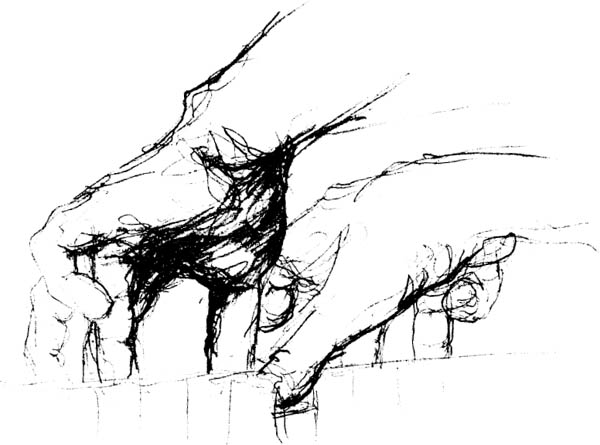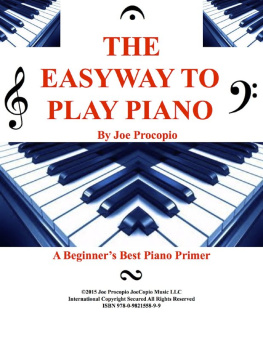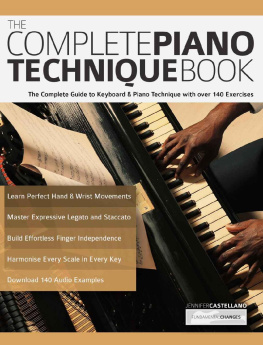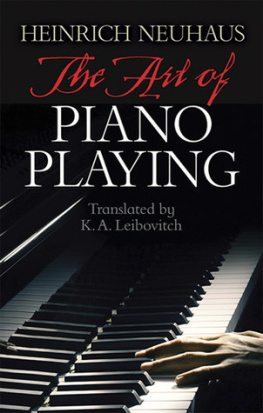THE CRAFT OF
PIANO PLAYING
A New Approach to Piano Technique
Alan Fraser
Illustrations by Sonya Ardan

SCARECROW PRESS, INC.
Published in the United States of America
by Scarecrow Press, Inc.
A Member of the Rowman & Littlefield Publishing Group
4501 Forbes Boulevard, Suite 200, Lanham, Maryland 20706
www.scarecrowpress.com
PO Box 317
Oxford
OX2 9RU, UK
Copyright 2003 by Alan Fraser
Excerpt from Awareness Through Movement by Moshe Feldenkrais in used by permission of HarperCollins
All rights reserved. No part of this publication may be reproduced,
stored in a retrieval system, or transmitted in any form or by any
means, electronic, mechanical, photocopying, recording, or otherwise,
without the prior permission of the publisher.
British Library Cataloguing in Publication Information Available
Library of Congress Cataloging-in-Publication Data
Fraser, Alan, 1955
The craft of piano playing: a new approach to piano technique / Alan Fraser ; illustrations by Sonya Ardan.
p. cm.
Includes bibliographical references (p. ) and index.
ISBN 0-8108-4591-1 (pbk. : alk. paper)
ISBN 978-0-8108-4591-6
1. PianoInstruction and study. I. Title.
MT220 .F8 2003
786.2'193dc21
2002190802
 The paper used in this publication meets the minimum requirements of American National Standard for Information SciencesPermanence of Paper for Printed Library Materials, ANSI/NISO Z39.48-1992.
The paper used in this publication meets the minimum requirements of American National Standard for Information SciencesPermanence of Paper for Printed Library Materials, ANSI/NISO Z39.48-1992.
Manufactured in the United States of America.
For Jelena
CONTENTS
SECTION I THE FOREGROUND
PIANISTIC PROBLEMS IN MUSICAL CRAFT
SECTION II THE MIDDLEGROUND
SOME GENERAL ASPECTS OF MUSICAL CRAFT
SECTION III THE BACKGROUND
TELL A STORY
Appendix I: Excerpts from Awareness Through Movement: A
Theoretical Framework
ILLUSTRATIONS
Frontispiece: Skeletal Counterpoint: empowered hand structure for optimal function |
MUSICAL EXAMPLES
APPLICATIONS
ACKNOWLEDGEMENTS
Not only many valued colleagues and friends helped me in preparing this book, but several people even nearer and dearer to mebringing the book to press has been largely a family affair. I would like to thank especially my father F. Clarke Fraser for his great help in editing the text. His clarity, insight and constant support helped keep the ball rolling when the task looked insurmountable. And my wifes uncle Zoran Nikolich was an invaluable source in our work on his Serbian translation. Reviewing the entire manuscript sentence by sentence became virtually the preparation of a second edition that has been incorporated into this first. Thanks to another invaluable translator, Meng Qui of Wuhan Conservatory, who fulfilled the daunting task of translating my complex ideas clearly to my Chinese students, and stimulated me to further clarity and exactitude in their expression. Thanks as well to Sonya Ardan for her talent, patience and understanding in preparing the illustrations.
My production team was superb. Warm thanks to Rebecca Massa, Debra Schepp, Beth Easter for her meticulous, insightful proofreading, and my typesetter Nenad Bogdanovich whose patience with me and skill with my materials remain unquantifiable!
Of the many personal friends who leant their valuable support, I would like to single out John Seely and Jerry Karzentheyll know why.
My debt to all my teachers is too great to be adequately acknowledged. I am especially grateful to Phil Cohen, a pioneer of true vision and genius who provided the seed for many of my key ideas. And warmest thanks to Kemal Gekich, a most highly esteemed colleague and dear friend whose youthful exuberance, personal magnetism, scathing wit, incisive perception, selfless dedication and awesome talent have all left their mark on both me and this book.
Finally, thanks to all my students both past and present, each of who in his or her own way was also my teacher.
SECTION I
THE FOREGROUND
PIANISTIC PROBLEMS IN
MUSICAL CRAFT

I
GETTING STARTED
In the professional world there is only one way to touch my heart, and that is to practice ones craft really well, be it conducting, singing, playing, making a wig, even polishing the brass...
Feodor Chaliapine
1 INTRODUCTION
A new approach
This book presents a new approach to the art of piano playing aimed at extending the physical and musical capacities of pianists from the dedicated amateur to top-level professionals. In it I have taken principles of movement from Feldenkrais Method and the Eastern martial arts and applied them to the dynamics of piano performance. My books title pays homage to Heinrich Neuhaus, the celebrated Russian pianist-pedagogue. Published over fifty years ago, Neuhaus monumental work The Art of Piano Playing still stands for many of us as the pianists bible. Hopefully my work will lead pianists to greater success in implementing his precepts, by showing them more clearly how. By filling in a missing link between musical intention and physical execution, this book aims to advance the craft of piano playing.
The process of reforming pianistic habits by means of a written text is not easy, as each pianist presents a unique set of acquired skills and unresolved problems. However, this system of movement physics at the keyboard aims to be comprehensive enough that each pianist may find the way to a fluid, capable untangling of some of the pianos most notorious technical Gordian knots.
Natural, individual and systematic human activity
Moshe Feldenkrais, creator of the method out of which much of my theory arises, cites three successive stages of development in all human activity: the natural, individual and methodical.jumping, walking or eating, are a common heritage: they function similarly in everyone. But occasionally an individual finds a special way of doing something, and if it is an improvement over the normal way, this tends to be adopted by those around him. Thus Australian aboriginals throw boomerangs, the Japanese learn judo, and North Americans go snowboarding! In the third stage, somebody observes the specialized activity and systematizes it, so that the process is now carried out according to a specific method as the result of knowledge and instruction, and no longer instinctively.
In the history of the various trades and arts practiced in the civilized world, we can find these three stages almost without exception. In the dawn of humanity people produced wonderful drawings naturally, and Leonardo da Vinci employed elementary principles of perspective, but it was only in the nineteenth century that these were fully defined; since then they have been taught in every school of art.
The simpler and more common an action is, the later will be the development of the third stage. Accepted methods were developed for the weaving of carpets, mapmaking, geometry and mathematics thousands of years ago, yet walking, standing and other basic activities are only now, through systems such as the Alexander Technique and Feldenkrais Method, reaching the third, or systematic stage. Where then does piano playing stand in all this?














 The paper used in this publication meets the minimum requirements of American National Standard for Information SciencesPermanence of Paper for Printed Library Materials, ANSI/NISO Z39.48-1992.
The paper used in this publication meets the minimum requirements of American National Standard for Information SciencesPermanence of Paper for Printed Library Materials, ANSI/NISO Z39.48-1992.